Standard operating procedures for mosquito vector surveillance, processing and storage
Tanya L L Russell, Kyran Staunton, Thomas R Burkot, Amanda Murphy
Disclaimer
Abstract
The purpose of this Standard Operating Procedure (SOP) is to outline processes for the surveillance, processing and storage of mosquito samples in the field.
A detailed vector surveillance plan is required to guide mosquito surveillance activities. The purpose and priority for vector surveillance should be outlined; as an example, routine surveillance may be conducted to understand:
· Adult vector occurrence, species composition and behaviour
· Vector insecticide resistance status
· Immature vector aquatic habitats
The work plan should map out the entomological indicators being monitored, timelines, milestones, staff requirements, sampling sites, sampling period, sampling methods, equipment, consumables, insectary maintenance, data management and dissemination, training and administrative requirements. The work plan will need to be fully costed within an approved budget.
As mosquito densities can vary greatly within even a limited area, a representative sample of the density of mosquitoes in a given surveillance site (i.e., a village or neighbourhood) requires collection of mosquitoes at multiple sampling stations (e.g., houses) to provide an accurate estimate of adult mosquito densities (Box 1). As an example, a minimum of 6 sampling stations (houses) per surveillance site (village or neighbourhood block) might be used to estimate adult mosquito densities. Depending on the resources available and size of the surveillance site, the number of sampling stations may be higher. This sampling effort is then replicated across multiple surveillance sites.
A wide variety of surveillance methods can be used to capture mosquitoes, and for each surveillance method a number of different collection tools may be used. The surveillance methods selected generally depend on the particular life stage and behaviour of the mosquito species being targeted (Silver 2008). Different methods may be employed to target different vector species of medical importance. The work plan will outline the surveillance methods and capture tools chosen for each vector surveillance site.
Before start
Community engagement
Community meetings should be held with the village elders and/or the entire village. Send advance notice of your intention to discuss the surveillance plan with the village before you travel to the village. The purpose of the meeting is to introduce yourselves and discuss the objective of the work as well as to receive permission to work in the village. Details include where the work will take place, and any advantages or disadvantages associated with the work.During the meeting allow questions to be asked and be sure to address any concerns that the village may have about the proposed work. If collectors are required, they should be recruited from each village when appropriate as this both provides employment and educates the community about mosquitoes.
Ethics approvals
Ethics approval for surveillance which involves using humans or animals as bait for mosquitoes may need to be obtained before starting any work, particularly if the mosquito collections are being performed for research purposes. Where approvals have been granted by your institution and/or your country’s Ethics Review Board, subsequent collection of mosquito samples must comply with the requirements of the permit.
Human ethics
The first priority of any study is the safety, confidentiality and dignity of any participants involved in the surveillance program. Participants must be over 18 years of age and not pregnant. The potential risks and benefits of the study will be discussed verbally in the local language with the aid of a participant information sheet detailing these issues in writing. The participants must provide written informed consent, and acknowledging their understanding that they are free to withdraw consent at any time.
Animal ethics
All activities relating to the care and use of animals for research should be conducted humanely. An animal is defined as any living non-human vertebrate (i.e. fish, amphibians, reptiles, birds and mammals). Where animals are used as lures to attract mosquitoes, the animal should not be unduly stressed, managed by its owner and have access to food and water. Different individual animals should be rotated over sequential nights of sampling to allow rest periods. Animals showing signs of agitation will be immediately released from the study. The owners will need to provide informed consent before the animal can be used.
Attachments
Steps
Overview of surveillance procedures
Preparation for vector surveillance activities
· Develop vector surveillance work plan, with required standard operating protocols.
· Secure the require funding.
· Gain required research or ethical approvals.
· Perform a stock-take and then order required equipment and consumables.
· Plan for data capture.
Logistics
· Send advance notice of your arrival to the village.
· Travel to the village that has been selected for the survey.
· Hold community meetings.
Sampling processes
· During each sampling period, capture mosquitoes as outlined in the work plan.
· Process the mosquito samples captured. This may involve killing, sorting and identifying the mosquitoes to species and sex.
· When necessary, store the mosquito samples. Ensure all samples are appropriately stored and labelled. Make sure all tubes, boxes and bags are SEALED carefully .
· Record the data, including details about the sampling design and the number of mosquitoes that were captured (by species and sex).
· Every time you leave a village, pack up your workstation and ensure no rubbish is left in the village. Thank the community before leaving.
Mosqutio sampling
Mosquitoes are to be captured with the sampling tools described in the work plan. There are some essential pieces of equipment that can be used alongside many sampling tools: namely oral aspirators and collection cups, described below.
Oral aspirators
Using an oral aspirator.
· With the mouthpiece in your mouth, hold the aspirator tube with its opening 1-2 cm away from the mosquito. Move the end of the aspirator tube closer to the mosquito and, at the same time, suck gently but quickly to pull the mosquito into the aspirator tube.
· Place your finger over the tube to prevent the mosquito from escaping but do not let the mosquito bite.
· Transfer the mosquitoes from the aspirator to the cup. Place the end of the tube, with your finger still in position, near the hole in the mesh covering the paper collection cup. Pull the cotton ball out of the hole in the middle of the cup. Remove your finger from the tube and quickly put the tube into the hole in the netting over the top of the collection cup. Blow gently into the mouthpiece so as to transfer the mosquito into the paper cup.

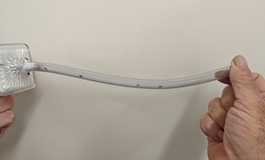
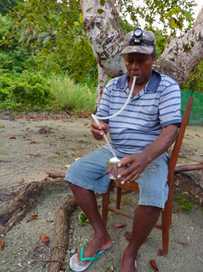
Collection cups
· Good collection cups may be ones which are paper with a waxy coating on the inside and are strong enough to not crumple when a rubber band is wrapped around them. On these cups you place a layer of mesh (10 cm x 10 cm or fit to size) and this mesh is held in place with a rubber band. Cut a 1 cm hole out of the middle of the mesh and place a cotton ball in this hole to prevent mosquitoes from escaping. All collection cups should be clearly labelled with the details of the sampling effort.
· Keep the collection cups or trap bags organized and protected while in the field. Placing the collection cups or trap bags upright in an airtight container or an insulated cool box. To keep mosquitoes alive and in good condition keep them in a cool place with high humidity and with access to a sugar source (i.e., cotton wool soaked in 10% sugar solution).
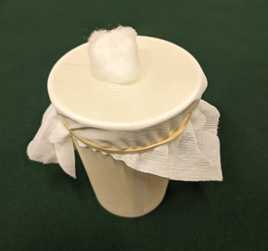
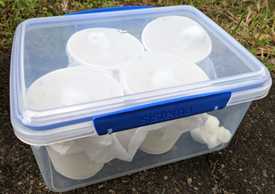
Processing adult mosquito samples
After the collection of the mosquito samples is completed, the next step is to process the mosquito samples. This may involve killing, sorting and identifying the mosquitoes to species and sex. These processes are outlined below.
Killing adult mosquito samples
The first step to processing adult mosquito samples usually involves killing or knocking them down (anaesthetizing) by:
· Mosquitoes being held in cups or small containers could be placed in a freezer. It will only take a short time for the mosquitoes to die in the freezer. They can be safely left in the freezer for an extended period before they are processed.
· A killing cup can be used to knock down the mosquitoes. A cotton ball moistened with ethyl acetate or chloroform could be placed on top of the cup mesh and covered to allow the vapours to concentrate and either knock down or kill the mosquitoes. Wait at least 1 – 2 minutes.
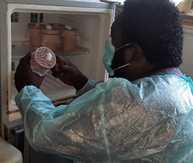

Morphological identification
Once all specimens are killed, taxonomic identification can occur in the field or back in the laboratory.
· Tip the dead adults from one sampling effort onto a petri dish or paper towel. Ensure you have adequate light to properly see the mosquitoes.
· Use a microscope or magnifying glass and a taxonomic key to identify each mosquito.
· Record the number of mosquitoes captured by taxonomic species and sex, also if specified by the work plan, record the physiological status (fed, unfed, gravid). Always record zero counts.
Storing mosquitoes
Appropriate needs to consider the intended purpose of the samples.
· For sequential molecular analyses, store the samples in small tubes containing enough 70 – 100% ethanol to cover the sample.
· If the mosquito morphology needs to be preserved, place the specimens in small tubes with desiccation beads separated by cotton wool.
· Note that 1.5 ml specimen tubes can comfortably contain up to 10 samples in ethanol and 5 samples with cotton wool and beads.

References
Silver, J.B. (2008) ‘Mosquito ecology: field sampling methods.’ 3rd edition; Springer: New York.



